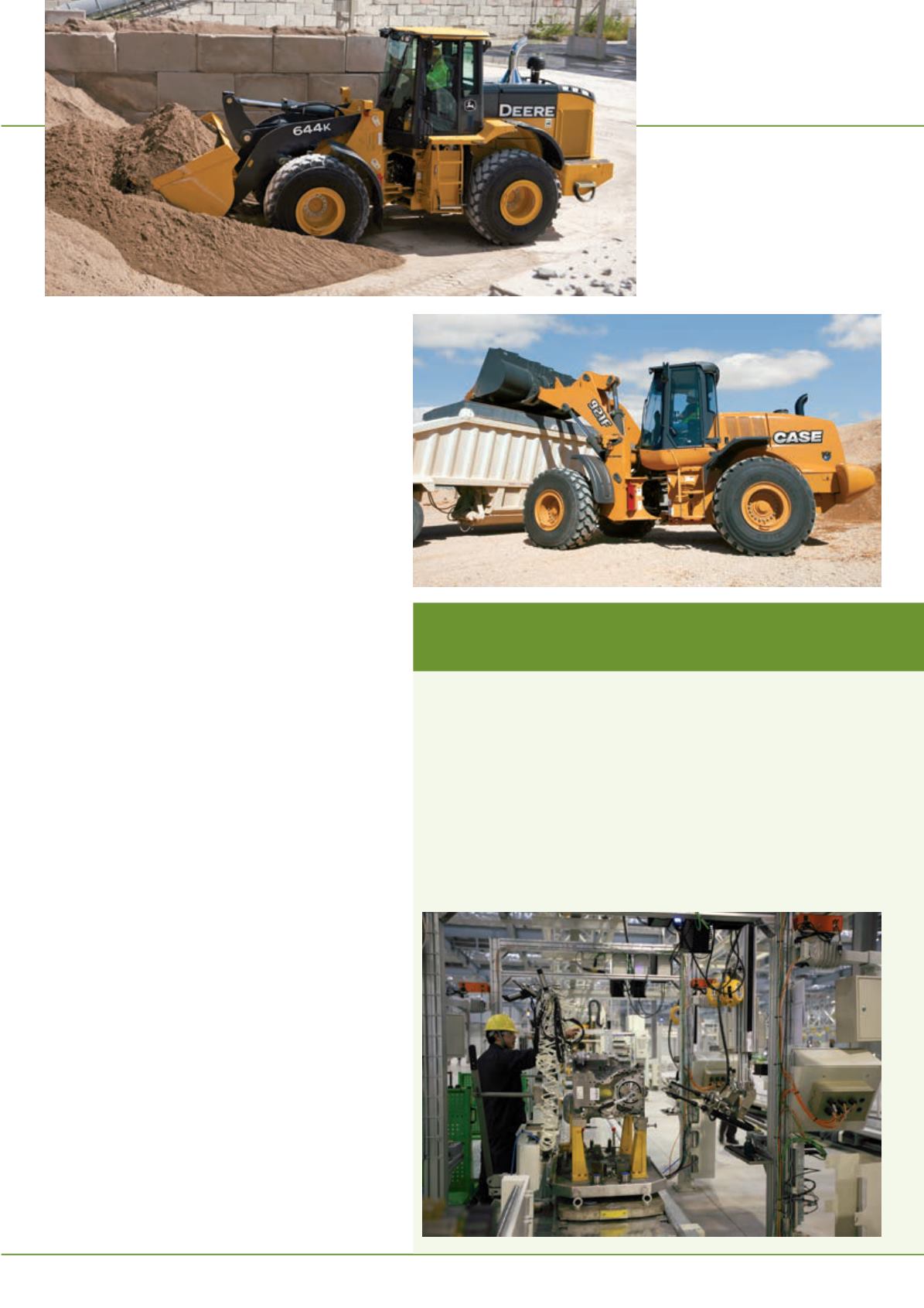
29
september 2014
international
construction
WHEELED LOADERS
Economy drive
>
andCaterpillar says that by integrating the various components
more deeply and improving efficiency in the hydraulics it has
eked out a 10% fuel consumption saving compared to the
equivalent K-seriesmodels.
Further down theweight categories, Cat’s 26 tonne 966M and
972M Tier 4 Final loaders are available with its XE advanced
powertrain, which offers even bigger fuel savings.The standard
M-series versions are said to consume -10% less fuel than their
predecessors, but the XE technology is said to deliver -25%
lower fuel consumption on average compared tomachines with
traditional torque converters. Caterpillar says this means they
offer the best fuel efficiency in their class.
The XE systemworks by having a hydrostatic andmechanical
transmission in parallel, with the two outputs combined using
a planetary gearbox. The hydrostatic system tends to be used a
low speeds, wheremechanical systems are inefficient, but as the
machine getsmoving themechanical system takes overmore is it
reaches its sweet spot.
This is all invisible to the operator, who just drives. In fact, the
operatingexperience shouldbebetter, as this typeof continuously
variable transmission (CVT) smoothes out gear changes.
Komatsu’s new additions to its range meanwhile have been
further down the weight categories, where the requirements
can be different. Unlike heavier loaders for pure production
applications, models like the new 11.8 tonne WA200-7 from
KomatsuAmerica and 15.3 tonneWA320-7 inEurope can find
themselves in a variety of applications.
So as opposed to theZ-bar linkage foundonheaviermachines,
these smaller loaders featureKomatsu’s parallel Z-bar, which still
provides highbreakout forces, but which can alsoparallel lift for
fork andpallet jobs.
BothmachinesarefittedwithTier4 Interim/Stage IIIBengines.
On the WA320-7, this makes for -10% less fuel consumption
and +12% more torque than on the predecessor model, the
WA320-6.
Some of the fuel savings are due to Komatsu’s Smart Loader
Logic system, which automatically matches the engine torque
and revs to the loads beingplacedon themachine’s systems.This
means fuel is not wasted but performance is not sacrificed.
At 11 to12.4 tonnes operatingweight,Hitachi’s newZW140-
5 andZW150-5 loaders are in a similar bracket.Thesemachines
claim a huge -20% reduction in fuel consumptionover previous
models thanks to the use of a hydrostatic transmission (HST),
and a display in the cab also helps by telling the operator when
themachine is being used at itsmost economical.
Auto engine shutdown is available as an option, and this
prevents unnecessary fuel use by stopping the engine after the
machine has stood in neutral with the parking brake on for a
minute.
Likewise, Liebherr’s latest mid-sized wheeled loaders feature a
hydrostaticdrive,which the company says contributes to a -25%
F
ollowing on from the signing of a joint venture agreement betweenCummins and
Liugong inOctober 2011, production at Guangxi Cummins Industrial Power Company
(GCIC) is nowwell underway.
One of the twomodels it produces is the 9.3 litre L9.3 for 5 tonne capacity (about 3m
3
bucket capacity) wheeled loaders. Although this 162 kW engine is fairly simple, with its
mechanical fuel pump and Tier 2 emissions compliance, it is a unique engine designed
specifically for this application– youwill not find a 9.3 litre engine elsewhere in theCummins
range.
The factory passed itsmilestone of producing its 10,000
th
engine in June this year, and the
immediate target is to be running at 50,000 engines per year for theChinese excavator and
wheeled loader sector. These engines are for use by Liugong, but also for sale to other OEMs
throughCummins’ national sales network.
Engines for China
Purpose-built units from Liugong-Cummins JV
John Deere hasmade improvements to axles on its utility
wheeled loaders alongwith the step up to Tier 4 Final
engines.
Case’s first Tier 4 Final loaders are the
821F and 921F, which offer a range
of features and options to cut fuel
consumption.


